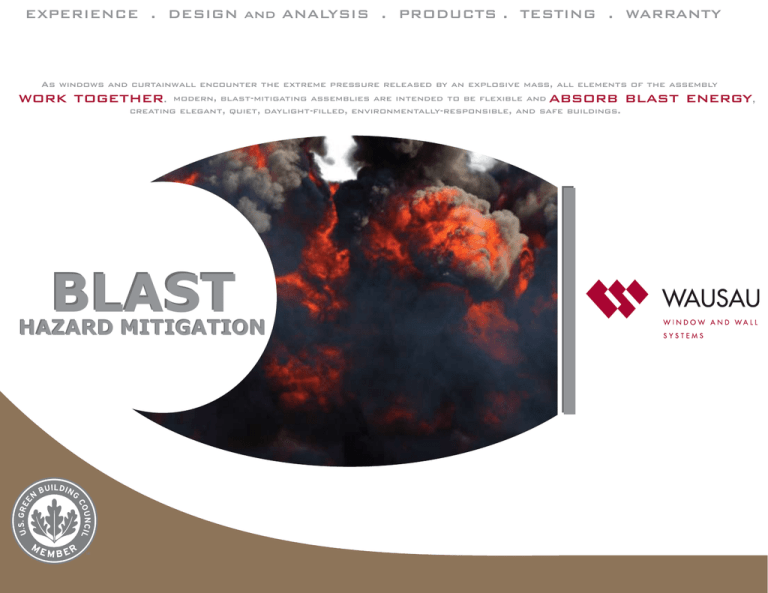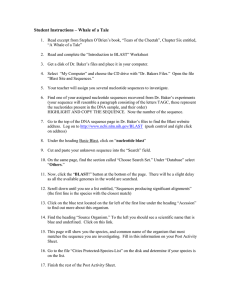
EXPERIENCE . DESIGN and ANALYSIS . PRODUCTS . TESTING . WARRANTY
As windows and curtainwall encounter the extreme pressure released by an explosive mass, all elements of the assembly
. modern, blast-mitigating assemblies are intended to be flexible and
creating elegant, quiet, daylight-filled, environmentally-responsible, and safe buildings.
work together
BLAST
HAZARD MITIGATION
absorb blast energy,
EXPERIENCE . DESIGN and ANALYSIS
With years of experience on dozens of major blast projects nationwide, Wausau can interpret the lexicon of blast hazard
mitigation, and design for safety and cost-effectiveness. Blast hardened re-cladding of an existing building, hazard-mitigating
replacement windows, or a modern all-glass facade for a new building, wausau has the technical expertise to
from inception to timely completion.
TAKE THE LEAD
GSA-ISC
DoD - UFC
General Services Administration Inter-Agency Security Committee
“Security Design Criteria for New Federal Office Buildings or Major Modernizations”
Performance Condition
1
2
3a
3b
4
5
Protection Level
Safe
Very High
High
High
Medium
Low
Hazard Level
None
None
Very Low
Low
Medium
High
GUIDE SPECIFICATION Blast Hazard Mitigation Design Requirements
1. Department of Defense (DoD) Unified Facilities Criteria
a. All calculations must be prepared by a Registered Structural Engineer directly contracted by, or in the employ of, the
manufacturer or glazing subcontractor, and address specific requirements of this project, including all framing materials to be
furnished as part of this contract. Calculations from other projects, non-representative test results on other systems, or other
qualitative analysis will not be acceptable in lieu of project-specific calculations.
b. Blast Loading: A multiple of equivalent three-second duration design load, based on ASTM F 2248, shall be used for
framing and connection design, in accord with Department of Defense (DoD) Unified Facilities Criteria UFC 4-010-01 “Minimum
Anti-Terrorism Standards for Buildings” 9 February 2012, Change 1, 1 October 2013
c. Applicable Level of Protection shall be ___________. [Specify “Very Low” or “Low”]
d. Standoff Distance shall be ___ feet. [Specify distance – IMPORTANT NOTE: Standoff Distance must be greater than 43 feet
for Charge Weight I, or 23 feet for Charge Weight II, otherwise this Wausau Guide Specification is inapplicable.]
e. Charge Weight ___ [Specify I or II]
Description of Window Glazing Response
No glazing breakage or visible damage.
Glazing cracks. Dusting of fragments.
Glazing cracks. Fragments on floor within 1m of window.
Glazing cracks. Fragments on floor within 3m of window.
Glazing cracks. Fragments impact lower 0.6m of wall.
System fails catastrophically.
1, 2
4
5
0.6m
3b
Zo
s
rin
ky
l
era
Fed
Omaha, Nebraska
ding
Buil
3a
1m
3m
Refer to Wausau Window and Wall Systems BHM product guide specifications for complete technical information, limitations and qualifications.
IMPORTANT NOTE: Determination of peak pressure, impulse, and Performance Condition (to include
Hazard Condition and Protection Level) is the responsibility of the Owner’s security/blast consultant;
not the window/curtainwall manufacturer or installer. Design parameters typically range from 4 psi
peak and 28 psi-msec impulse, to 10 psi peak and 89 psi-msec impulse.
(IMPORTANT NOTE: Determination of applicable Level of Protection, Stand-Off Distance and Charge Weight is the responsibility of
the Owner’s security/blast consultant; not the window manufacturer or installer.)
f. Refer to Section 08 80 00 for glass design, analysis, and selection requirements in accord with DoD UFC 4-010-01, ASTM F
2248 and ASTM E 1300.
g. Framing Deflection: Limit deflection of frame members, in a direction normal to the wall, to 1/60 of the supported glazing
edge dimension, at two times the glazing load resistance.
h. Glass Support: Comply with glass bite and structural silicone joint width requirements of DoD UFC 4-010-01.
i. For structural silicone glazed systems, joint width must be one to two times the thickness of the glass to which it is adhered.
i. For monolithic glass, structural silicone shall be applied to both faces.
ii. For insulating glass units, structural silicone shall be applied to the inboard face.
j. For systems that do not utilize structural silicone:
i. Provide glass bite no less than four times the inboard glass thickness, and
ii. Provide dynamic analysis indicating adequacy of glass bite across the full range of unit size variation, validated by shock
tube or open arena testing at a laboratory accredited specifically for blast testing.
k. Provide project-specific calculations indicating adequacy of anchorage. Static analysis of dry-glazed systems not permitted.
l. Connections and Anchors: All frame-to-frame connections and connections to the building, shall be designed using ASTM
F2248 under the assumption that the glazing must fail before the frame members and their connections. To ensure this,
connections shall be designed to at least the following levels:
i. Two times the glass load resistance, if the maximum airblast pressure is greater than
one-half the glass load resistance, or
ii. The glass load resistance, if the maximum airblast pressure is less than
one-half the glass load resistance.
iii. Allowable stresses shall be as published by AISC, ACI, AISI or
the manufacturer, for the respective materials used in each component.
iv. Geometry and connection configuration shall be taken into
account in calculation of loads on connections and anchors.
m. Other Loads: In addition to blast loads, all components must
be designed to satisfy applicable code requirements for adequate
glass support, wind and gravity loads.
n. Shock tube or open arena testing, at a laboratory accredited
specifically for blast testing, may be acceptable in lieu of static or
dynamic analysis, if sizes and configurations tested comply fully with
the limitations of USACE/NAVFAC/AFCESA/NASA UFGS-08 51 13
“Unified Facilities Guide Specification.”
Blast Hazard Mitigating (BHM)
8000 - BHM
INvisionTM Unitized
PRODUCTS
Blast performance up to 33 psi peak
pressure, 81 psi-msec impulse
INvision - BHM
8"
Thermally improved; polyamide
thermal barrier optional
Structural silicone glazing and sealing
in a controlled factory environment
Accepts up to 3/4" total
vertical movement
3"
Unitized Curtainwall
Interlocking frame design
accommodates seismic, live load
and thermal building movements
GSA Federal Building Re-Cladding
Des Moines, Iowa
Exterior sun shades and
interior light shelves
BHM SuperWallTM
Blast performance up to 33 psi peak
pressure, 81 psi-msec impulse
Exterior sun shades and
interior light shelves
Blast performance up to 33 psi peak
pressure, 81 psi-msec impulse
INventTM 2250i - BHM
Factory Glazed
AAMA AW-100 air, water and
structural performance
3"
Curtainwall
Screw-spline construction
BHM SuperWall
Captured or vertical structural glazed
Windows
7 1/4"
3" exterior sight line
INvent - BHM
Several frame depths including
cladding for steel tubes
BHM zero-sightline vents and
terrace doors available
2 1/2"
1/8" principal wall thickness
Fixed, project-out awning, hopper,
project-out or project-in casement
4 3/16"
Polyamide thermal barrier
Integrally extruded anchor leg, slide-in
anchors or receptors
Also available in 3 1/2" and 4 1/2"
High recycled content aluminum framing
Richmond Federal Courthouse
Richmond, Virginia
TESTING
WARRANTY
8000i - BHM Full Scale
Open Arena Blast Test
For more than 50 years, Wausau has worked closely with architects,
building owners and contractors to realize their vision for
,
while striving to maintain the highest level of customer service,
communication and overall satisfaction.
aesthetics, sustainability and lasting value
Testing is used to validate inelastic dynamic analysis.
+
Pressure (psi)
Peak Pressure
Before
Testing
-
Positive Phase Impulse
Time (msec)
Negative Phase Impulse
Impulse = Area under
Pressure-Time Curve (psi-msec)
WAUSAU WINDOW and WALL SYSTEMS
Full Scale Open Arena Blast Test Results
Maximum
Inward
Load
Maximum
Outward
Response
Description
Testing Laboratory
HTL, LLC
Test Method(s)
ASTM F1642 and GSA-TS01-2003
System Tested
8000 -BHM Series Curtainwall
Performance Class
10 psi – 89 psi-msec
Overall Size
120" high x 143-5/8" wide per ASTM 510-06
Location
Lynn County, Texas
Test Date and Time
4:00 PM CDT, March 10, 2009
81°F, 16% RH
Ambient Temperature and RH
Weather Conditions
Mostly Cloudy, winds 10-15 mph
Explosive Charge
Charge Type
ANFO (Ammonium Nitrate Fuel Oil)
Charge Weight
850 lbs
Standoff Distance
129 ft
Summary of Results
Reflected Blast Wave Peak Pressure 11.23 psi
(exceeds Performance Class)
Positive Phase Impulse
90.62 psi-msec (exceeds Performance Class)
Hazard Rating/Performance Condition
GSA Performance Condition
3b
ASTM
Very Low Hazard
UFC Level of Protection
Low (Refer to Page 2)
After
Testing
Visit www.wausauwindow.com for guide specifications,
testing video clips, and complete product information.
"INvent," "INvision" and "SuperWall" are trademarks of Apogee Wausau
Group, Inc. All rights reserved. ©2014 Apogee Wausau Group, Inc.
7800 International Drive
Wausau, WI 54401
Toll Free 1 877 678 2983 Fax 1 715 843 4350
E-Mail info@wausauwindow.com



